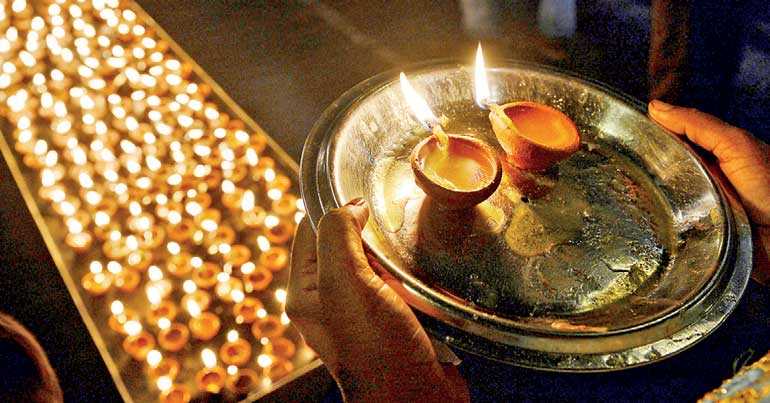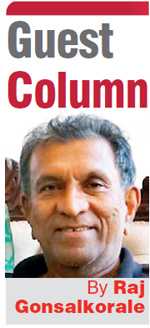Monday Apr 21, 2025
Monday Apr 21, 2025
Tuesday, 4 August 2020 00:24 - - {{hitsCtrl.values.hits}}

As much as the Sinhala Buddhist culture and its richness should be recognised, the Tamil culture, in particular the Tamil Hindu culture and its universality, too needs to be recognised. All Sri Lankans should be proud that the country has two such ancient cultures as its foundation – Pic by Shehan Gunasekara
Culture is the characteristics and knowledge of a particular group of people, encompassing language, religion, cuisine, social habits, music and arts. ... The word “culture” derives from a French term, which in turn derives from the Latin “colere,” which means to tend to the earth and grow, or cultivation and nurture
In contemporary Sri Lanka, the Northern Province has a Tamil population of 93.8% and the Eastern Province a Tamil population of 39.2%, as per statistics from the Census conducted by the Department of Census and Statistics in 2012. 
Nationally, 51.5% of all Tamils in the country live in the Northern and Eastern Provinces, while 48.5% live outside these two provinces. In reality, 48.5% of the Tamil population lives as minorities in seven of the nine provinces in the country. In the Eastern Province, the Tamil population is a minority if the Sinhala and Muslim population is combined.
Perhaps the biggest road block to a solution to what is referred to as the “Tamil” problem is the historical Tamil homeland theory that Tamils, excepting the Tamil population predominantly in the plantation sector, have advocated as the basis for a solution.
The homeland theory that encompasses the Northern and Eastern Provinces is a much debated and disputed theory, and if that were to be the basis, it is unlikely that there will ever be a solution. Neither will there be a solution on the basis of a view that Sinhala Buddhist predominance, with Tamils and other ethnic groups being accommodated within such a predominance should be the basis for a solution.
The strength of cultural diversity
A basis for a solution perhaps might be oriented in culture, and the recognition that in contemporary Sri Lanka, the Tamil cultural centre is the Northern Province of the country. If this were to be accepted as the basis for a solution, and the historical homeland theory is replaced with it, it may be possible to move forward in finding a political solution for this problem.
Tamil civilisation reportedly had its beginnings 11,000 years or so ago or circa 9,000 BC in India. Whilst it is not the intention here to get into a debate about the history of Tamil culture in India, it needs to be said that there is universal agreement that it is a very old culture. It is equally an old culture of Sri Lanka, and along with the ancient Sinhala Buddhist culture, are the two predominant cultural foundations of the country. Other cultures have enriched the cultural landscape of the country.
As much as the Sinhala Buddhist culture and its richness should be recognised, the Tamil culture, in particular the Tamil Hindu culture and its universality, too needs to be recognised. All Sri Lankans should be proud that the country has two such ancient cultures as its foundation.
It is in this context that a suggestion is being made to explore a political solution to the Tamil problem from a cultural perspective first and a political perspective, second. This suggestion requires an acceptance of this premise by both parties concerned.
If both do not work together in partnership and mutual acceptance of this premise, there will not be a solution.
Importance of symbolism
What does this mean and how could this be done? Religious leaders are a key element of such a partnership. Religious leaders on both sides need to reach out to each other and demonstrate their partnership. Imagine the symbolism of the Mahanayake Theros of all Nikayas visiting key Hindu kovils in the country and Hindu religious dignitaries visiting the Mahanayakes and also the historic places of Buddhist worship.
While political leaders amongst the Sinhala Buddhist community pay their traditional respects to the Buddhist institutional heads, the Mahanayake Theros, one is yet to see Tamil political leaders paying courtesy calls on the Mahanayakes. If they do, again, the symbolism would help in breaking barriers that are impeding the finding of a solution.
While the Buddhist institution does not represent a custodianship of Buddha Dhamma primarily as the Dhamma does not need custodians and it is in the minds of individuals, it does play a major role amongst Buddhists in Sri Lanka. The Buddhist institution represents the Theravada traditions and the Mahanayake Theros are seen as the custodians of these traditions.
Symbolism from leaders of both partners will go a long way to reduce and remove the distrust some on both sides have about each other. Removing that distrust will be a key to finding a political solution as it is this distrust that has stood in the way of a solution.
Beyond the symbolism, regular contacts amongst leaders in both cultural groupings and participating in events of significance for both partners would have immense value as they will send signals to communities represented by the partners who will then recognise the equality of everyone in a more meaningful way.
Politics and demographic realities
The Northern Province should be recognised as the cultural centre of Tamils because of their historical and contemporary plurality in the province. The Tamil community should also realise that they are and will be the minor community in all other provinces except the Eastern Province where they are in almost identical numbers as the Sinhala and Muslim community. Then there is the Tamil community in the plantation sector.
A political solution cannot be found unless there is recognition of these demographic realities. If culture is placed above politics, there will be less division and a greater chance for social equality through mutual respect for each other’s culture both of which are rich and ancient. Bridges have to be built between communities and when that is done and differences are recognised as things that will enhance the country’s richness, the nature of political demands may change along with the change in people’s mindset.
If culture becomes the unifying force, learning each other’s language, religion, cuisine, social habits, music and arts could flourish in all parts of the country without any party having to compromise on cultural practices as long as they are within the law of the country.
Not just divisions between ethnic communities arising from political imperatives, but divisions within communities arising from issues such as caste could assume less significance and gradually abate as cultural practices could breakdown internal barriers as well as external barriers between communities.
However, having presented this view of cultural diversity being a healer, and an equaliser, dominance by one culture in politics and government will not be seen as such. This is a reality that has been witnessed for a long time. Cultural preferences, in particular language, has overshadowed merit when it came to jobs, especially in the government sector.
Cultural diversity and politics
Writing in the Asian Society journal, Dai Le and Katie Calvey says in an article titled Cultural Diversity in Politics and Media Will Create National Prosperity (https://asiasociety.org/australia/cultural-diversity-politics-and-media-will-create-national-prosperity) that cultural diversity is often publicly promoted as part of Australia’s DNA and as the former Prime Minister Malcolm Turnbull puts it, Australia is the “most successful multicultural society in the world. There is no other country that has done so well at this as we have.”
However, Dai Le and Katie Calvey asks the question, “But is it fair for Australia to showcase itself to the world as the most successful multicultural nation, if diversity is not visible in our public discourse? For instance, Screen Australia found that within Australian television dramas broadcasted between 2011 to 2015, only 18% of main characters were of non-Anglo Celtic background.”
They go on to say that “more glaring within senior positions of decision making in Australia’s major institutions is the invisibility of people of colour. For example, if one were to review the current composition of the Australian Parliament to which the Prime Minister belongs to, an overwhelming 79% of the total 226 elected politicians are people of Anglo-Celtic background. Politicians of Asian heritage make up less than 4%.”
A multi-cultural society through the richness of its cultural diversity has to translate that multiculturalism to genuine equality of opportunities as well. Multi-cultural labels should not become façades for deceptions. If cultural composites of each community act as barriers rather than as unifiers and equalisers, there is less likelihood of a political solution arising through the positives of cultural diversity. Language in particular should not become a barrier, and learning and using each other’s languages would bring the different communities closer.
In this regard symbolism is important as well. In Sri Lanka, while several Tamil politicians speak in Sinhala, one is yet to see a Sinhala politician speaking in Tamil. Prime Minister Mahinda Rajapaksa was perhaps the only Head of State who has spoken in Tamil at public meetings in Tamil areas, and to his credit, he is the first and probably the only leader of a country so far to have spoken in Tamil at the United Nations General Assembly in New York. One is yet to see leaders of the Buddhist Nikayas in Hindu kovils and also yet to see Hindu religious dignitaries in Buddhist places of worship. If this position changes and these leaders forge new partnerships, there could be far-reaching changes within the Sri Lankan society.